Molecular Characterization of a Recombinant NADC30-like PRRSV Strain with a Novel Gene Deletion Pattern in Nsp2 Gene
Abstract
Simple Summary
Abstract
1. Introduction
2. Materials and Methods
2.1. Sample Collection and Detection
2.2. Virus Isolation
2.3. Immunofluorescence Assay (IFA)
2.4. Characterization of In Vitro Growth Properties in PAMs
2.5. Genome Sequencing and Analysis
2.6. Confirmation of Nsp2 Deletion by PCR
2.7. Recombination Analysis
2.8. Statistical Analyses
3. Results
3.1. Virus Isolation and Identification
3.2. Genome Sequencing and Phylogenetic Analysis
3.3. Homology Analysis
3.4. Amino Acid Deletion Analysis in Nsp2
3.5. Amino Acid Analysis of GP3
3.6. Amino Acid Analysis of GP5
3.7. Identification and Characterization of Recombinant Events and Genomic Regions
4. Discussion
Supplementary Materials
Author Contributions
Funding
Institutional Review Board Statement
Informed Consent Statement
Data Availability Statement
Conflicts of Interest
References
- Dey, S.; Bruner, J.; Brown, M.; Roof, M.; Chowdhury, R. Identification and biophysical characterization of epitope atlas of Porcine Reproductive and Respiratory Syndrome Virus. Comput. Struct. Biotechnol. J. 2024, 23, 3348–3357. [Google Scholar] [CrossRef]
- Scanlan, C.L.; Putz, A.M.; Gray, K.A.; Serão, N.V.L. Genetic analysis of reproductive performance in sows during porcine reproductive and respiratory syndrome (PRRS) and porcine epidemic diarrhea (PED) outbreaks. J. Anim. Sci. Biotechnol. 2019, 10, 22. [Google Scholar] [CrossRef]
- Rashidi, H.; Mulder, H.A.; Mathur, P.; van Arendonk, J.A.; Knol, E.F. Variation among sows in response to porcine reproductive and respiratory syndrome. J. Anim. Sci. 2014, 92, 95–105. [Google Scholar] [CrossRef] [PubMed]
- Xu, S.; Zhao, Y.; Shen, J.; Lin, Y.; Fang, Z.; Che, L.; Wu, D. Threonine and tryptophan supplementation enhance porcine respiratory and reproductive syndrome (PRRS) vaccine-induced immune responses of growing pigs. Anim. Sci. J. 2015, 86, 294–304. [Google Scholar] [CrossRef] [PubMed]
- Yim-Im, W.; Anderson, T.K.; Böhmer, J.; Baliellas, J.; Stadejek, T.; Gauger, P.C.; Krueger, K.M.; Vermeulen, C.J.; Buter, R.; Kazlouski, A.; et al. Refining genetic classification of global porcine reproductive and respiratory syndrome virus type 1 (PRRSV-1) and investigating their geographic and temporal distributions. Vet. Microbiol. 2025, 302, 110413. [Google Scholar] [CrossRef]
- Yim-Im, W.; Anderson, T.K.; Paploski, I.A.D.; VanderWaal, K.; Gauger, P.; Krueger, K.; Shi, M.; Main, R.; Zhang, J. Refining PRRSV-2 genetic classification based on global ORF5 sequences and investigation of their geographic distributions and temporal changes. Microbiol. Spectr. 2023, 11, e0291623. [Google Scholar] [CrossRef]
- Lunney, J.K.; Fang, Y.; Ladinig, A.; Chen, N.; Li, Y.; Rowland, B.; Renukaradhya, G.J. Porcine Reproductive and Respiratory Syndrome Virus (PRRSV): Pathogenesis and Interaction with the Immune System. Annu. Rev. Anim. Biosci. 2016, 4, 129–154. [Google Scholar] [CrossRef]
- Sha, H.; Zhang, H.; Chen, Y.; Huang, L.; Zhao, M.; Wang, N. Research Progress on the NSP9 Protein of Porcine Reproductive and Respiratory Syndrome Virus. Front. Vet. Sci. 2022, 9, 872205. [Google Scholar] [CrossRef] [PubMed]
- Li, Y.; Wang, X.; Jiang, P.; Chen, W.; Wang, X. Genetic analysis of two porcine reproductive and respiratory syndrome viruses with different virulence isolated in China. Arch. Virol. 2008, 153, 1877–1884. [Google Scholar] [CrossRef]
- Liu, B.; Luo, L.; Shi, Z.; Ju, H.; Yu, L.; Li, G.; Cui, J. Research Progress of Porcine Reproductive and Respiratory Syndrome Virus NSP2 Protein. Viruses 2023, 15, 2310. [Google Scholar] [CrossRef]
- Zhu, Z.; Yuan, L.; Hu, D.; Lian, Z.; Yao, X.; Liu, P.; Li, X. Isolation and genomic characterization of a Chinese NADC34-like PRRSV isolated from Jiangsu province. Transbound. Emerg. Dis. 2022, 69, e1015–e1027. [Google Scholar] [CrossRef]
- Li, G.; Li, Y.; He, C.; Liu, X.; Lv, C.; Liu, K.; Yu, X.; Zhao, M. Sequence analysis of the GP5 protein of porcine reproductive and respiratory syndrome virus in Vietnam from 2007 to 2023. Front Microbiol. 2024, 15, 1475208. [Google Scholar] [CrossRef] [PubMed]
- Luo, Q.; Zheng, Y.; Zhang, H.; Yang, Z.; Sha, H.; Kong, W.; Zhao, M.; Wang, N. Research Progress on Glycoprotein 5 of Porcine Reproductive and Respiratory Syndrome Virus. Animals 2023, 13, 813. [Google Scholar] [CrossRef]
- Lv, C.; Zheng, Y.; Liu, K.; Li, G.; Luo, Q.; Zhang, H.; Sha, H.; Wang, R.; Kong, W.; Zhao, M. Genetic variation and recombination analysis of PRRSV-2 GP3 gene in China from 1996 to 2023. Front. Microbiol. 2024, 15, 1435373. [Google Scholar] [CrossRef] [PubMed]
- Vu, H.L.; Kwon, B.; Yoon, K.J.; Laegreid, W.W.; Pattnaik, A.K.; Osorio, F.A. Immune evasion of porcine reproductive and respiratory syndrome virus through glycan shielding involves both glycoprotein 5 as well as glycoprotein 3. J. Virol. 2011, 85, 5555–5564. [Google Scholar] [CrossRef]
- Zhang, Y.; Zhang, K.; Zheng, H.; Liu, C.; Jiang, Y.; Du, N.; Li, L.; Li, G.; Yu, L.; Zhou, Y.; et al. Development of a Monoclonal Antibody Against Porcine CD163 SRCR5 Domain Which Partially Blocks Infection of PRRSV. Front. Vet. Sci. 2020, 7, 597843. [Google Scholar] [CrossRef]
- Zhang, H.; Luo, Q.; Zheng, Y.; Sha, H.; Li, G.; Kong, W.; Huang, L.; Zhao, M. Genetic Variability and Recombination of the NSP2 Gene of PRRSV-2 Strains in China from 1996 to 2021. Vet. Sci. 2023, 10, 325. [Google Scholar] [CrossRef]
- Zhang, S.; Xu, H.; Guo, Z.; Xiang, L.; Li, C.; Gong, B.; Li, J.; Feng, Z.; Kang, H.; Wang, Q.; et al. Genomic characteristics and epidemic trends of NADC30-like PRRSV in China. Porcine Health Manag. 2025, 11, 30. [Google Scholar] [CrossRef]
- Sun, Y.; Xing, J.; Hong, S.L.; Bollen, N.; Xu, S.; Li, Y.; Zhong, J.; Gao, X.; Zhu, D.; Liu, J.; et al. Untangling lineage introductions, persistence and transmission drivers of HP-PRRSV sublineage 8.7. Nat. Commun. 2024, 15, 8842. [Google Scholar] [CrossRef] [PubMed]
- Chen, N.; Ye, M.; Xiao, Y.; Li, S.; Huang, Y.; Li, X.; Tian, K.; Zhu, J. Development of universal and quadruplex real-time RT-PCR assays for simultaneous detection and differentiation of porcine reproductive and respiratory syndrome viruses. Transbound. Emerg. Dis. 2019, 66, 2271–2278. [Google Scholar] [CrossRef]
- Yu, P.; Wei, R.; Dong, W.; Zhu, Z.; Zhang, X.; Chen, Y.; Liu, X.; Guo, C. CD163ΔSRCR5 MARC-145 Cells Resist PRRSV-2 Infection via Inhibiting Virus Uncoating, Which Requires the Interaction of CD163 With Calpain 1. Front. Microbiol. 2020, 10, 3115. [Google Scholar] [CrossRef]
- Yuan, L.; Zhu, Z.; Fan, J.; Liu, P.; Li, Y.; Li, Q.; Sun, Z.; Yu, X.; Lee, H.S.; Tian, K.; et al. High Pathogenicity of a Chinese NADC34-like PRRSV on Pigs. Microbiol. Spectr. 2022, 10, e0154122. [Google Scholar] [CrossRef]
- Chang, H.; Gao, X.; Wu, Y.; Wang, F.; Lai, M.; Zheng, J.; Qiu, Y.; He, Y.; Liang, X.; Yuan, K.; et al. Genomic and pathogenicity analysis of two novel highly pathogenic recombinant NADC30-like PRRSV strains in China, in 2023. Microbiol. Spectr. 2024, 12, e0036824. [Google Scholar] [CrossRef]
- Delrue, I.; Van Gorp, H.; Van Doorsselaere, J.; Delputte, P.L.; Nauwynck, H.J. Susceptible cell lines for the production of porcine reproductive and respiratory syndrome virus by stable transfection of sialoadhesin and CD163. BMC Biotechnol. 2010, 10, 48. [Google Scholar] [CrossRef] [PubMed]
- Zhang, H.L.; Tang, Y.D.; Liu, C.X.; Xiang, L.R.; Zhang, W.L.; Leng, C.L.; Wang, Q.; An, T.Q.; Peng, J.M.; Tian, Z.J.; et al. Adaptions of field PRRSVs in Marc-145 cells were determined by variations in the minor envelope proteins GP2a-GP3. Vet. Microbiol. 2018, 222, 46–54. [Google Scholar] [CrossRef] [PubMed]
- Han, J.; Liu, G.; Wang, Y.; Faaberg, K.S. Identification of nonessential regions of the nsp2 replicase protein of porcine reproductive and respiratory syndrome virus strain VR-2332 for replication in cell culture. J. Virol. 2007, 81, 9878–9890. [Google Scholar] [CrossRef]
- de Lima, M.; Pattnaik, A.K.; Flores, E.F.; Osorio, F.A. Serologic marker candidates identified among B-cell linear epitopes of Nsp2 and structural proteins of a North American strain of porcine reproductive and respiratory syndrome virus. Virology 2006, 353, 410–421. [Google Scholar] [CrossRef] [PubMed]
- Saenglub, W.; Jantafong, T.; Mungkundar, C.; Romlamduan, N.; Pinitkiatisakul, S.; Lekcharoensuk, P. Genetic signatures of the immune-escaping type 2 porcine reproductive and respiratory syndrome virus in farms with a robust vaccination program. Microb. Pathog. 2020, 144, 104166. [Google Scholar] [CrossRef]
- Shental-Bechor, D.; Levy, Y. Effect of glycosylation on protein folding: A close look at thermodynamic stabilization. Proc. Natl. Acad. Sci. USA 2008, 105, 8256–8261. [Google Scholar] [CrossRef]
- Wei, Z.; Lin, T.; Sun, L.; Li, Y.; Wang, X.; Gao, F.; Liu, R.; Chen, C.; Tong, G.; Yuan, S. N-linked glycosylation of GP5 of porcine reproductive and respiratory syndrome virus is critically important for virus replication in vivo. J. Virol. 2012, 86, 9941–9951. [Google Scholar] [CrossRef]
- Rupasinghe, R.; Lee, K.; Liu, X.; Gauger, P.C.; Zhang, J.; Martínez-López, B. Molecular Evolution of Porcine Reproductive and Respiratory Syndrome Virus Field Strains from Two Swine Production Systems in the Midwestern United States from 2001 to 2020. Microbiol. Spectr. 2022, 10, e0263421. [Google Scholar] [CrossRef] [PubMed]
- Wu, Q.; Li, Z.; Zhang, G.; Niu, J.; Zeng, X.; Sun, B.; Ma, J. Genetic diversity and phylogenetic analysis of porcine reproductive and respiratory syndrome virus in southern China from 2007 to 2014. J. Vet. Sci. 2017, 18, 317–326. [Google Scholar] [CrossRef] [PubMed]
- Paploski, I.A.D.; Makau, D.N.; Pamornchainavakul, N.; Baker, J.P.; Schroeder, D.; Rovira, A.; VanderWaal, K. Potential Novel N-Glycosylation Patterns Associated with the Emergence of New Genetic Variants of PRRSV-2 in the U.S. Vaccines 2022, 10, 2021. [Google Scholar] [CrossRef] [PubMed]
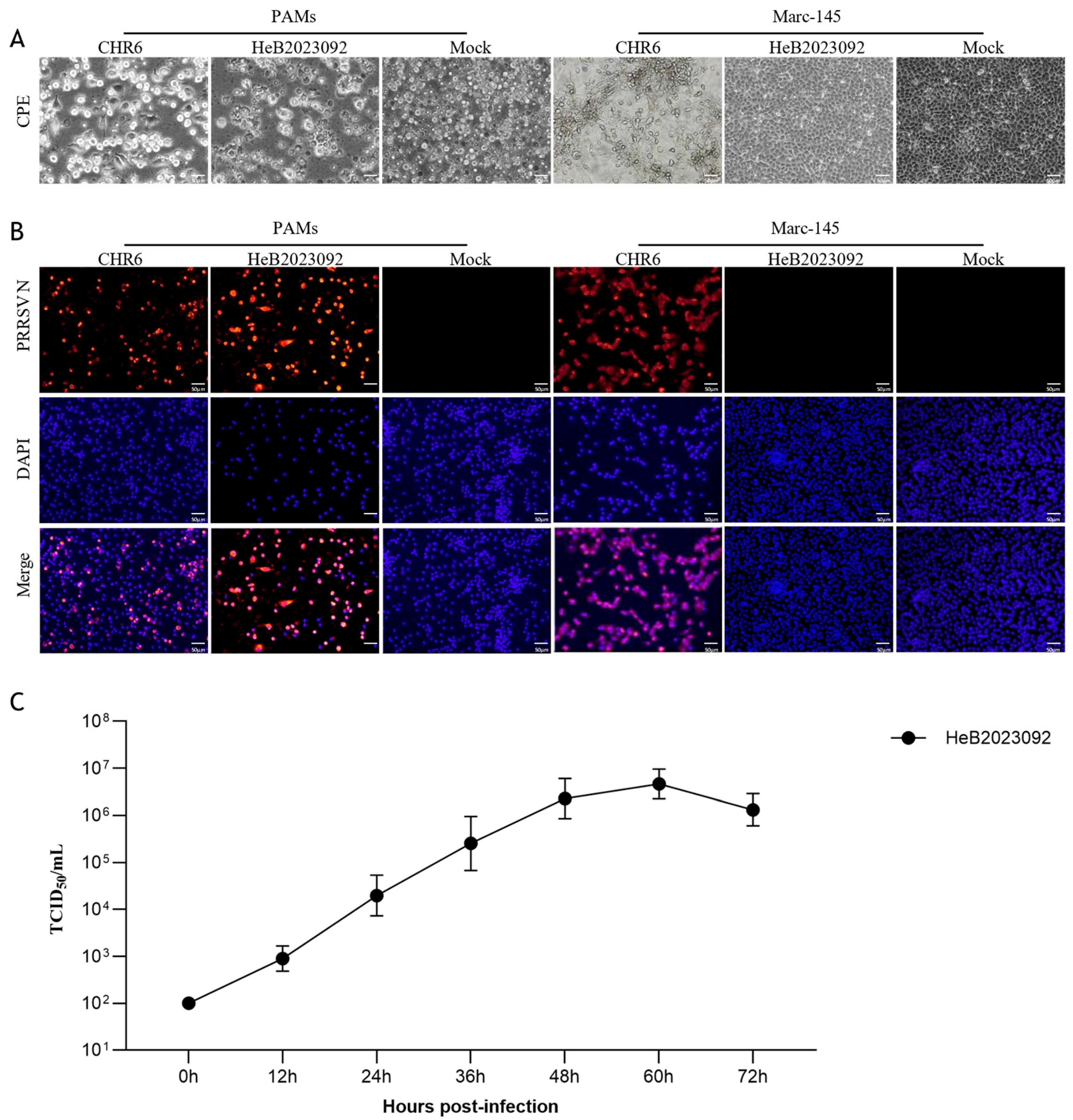
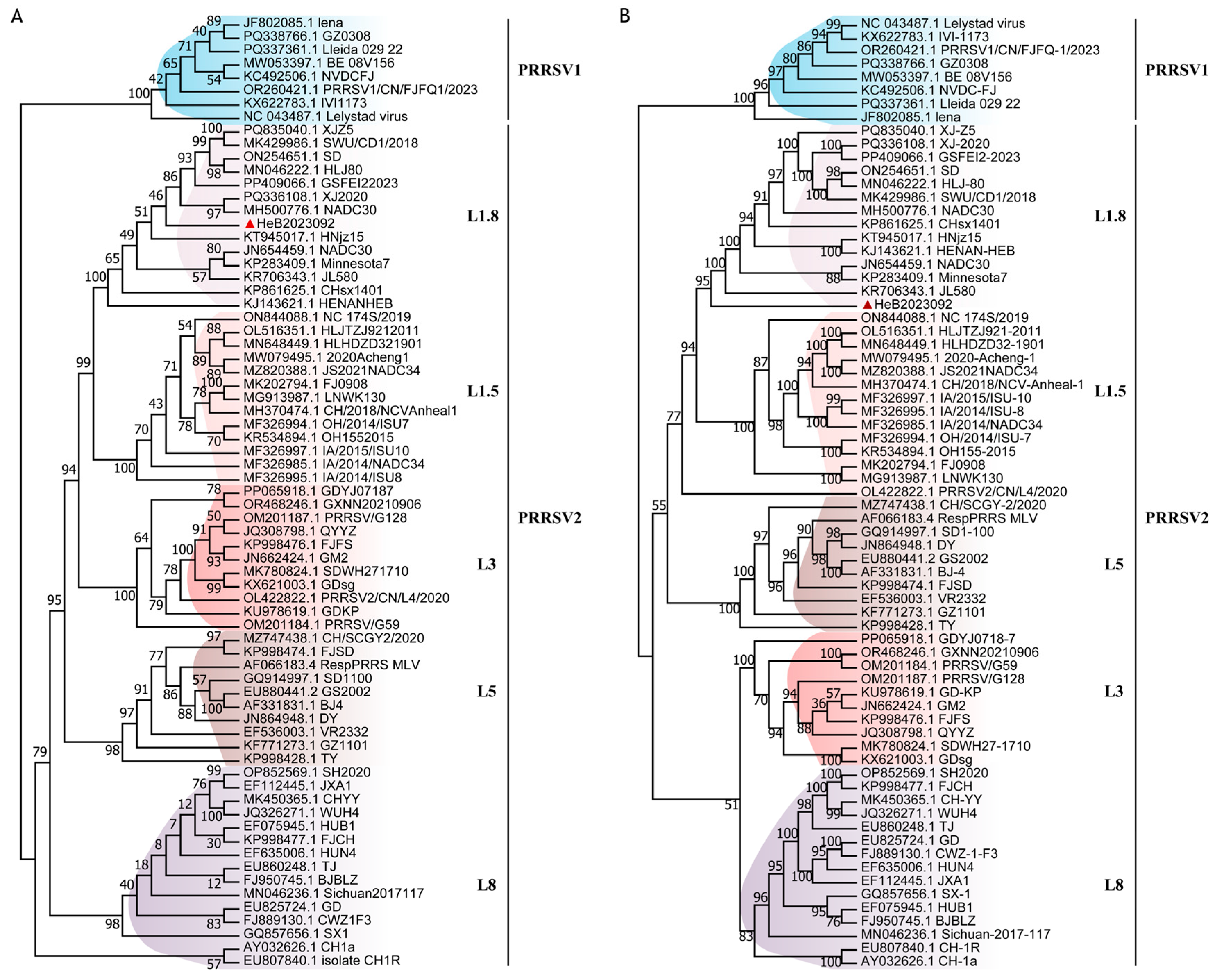

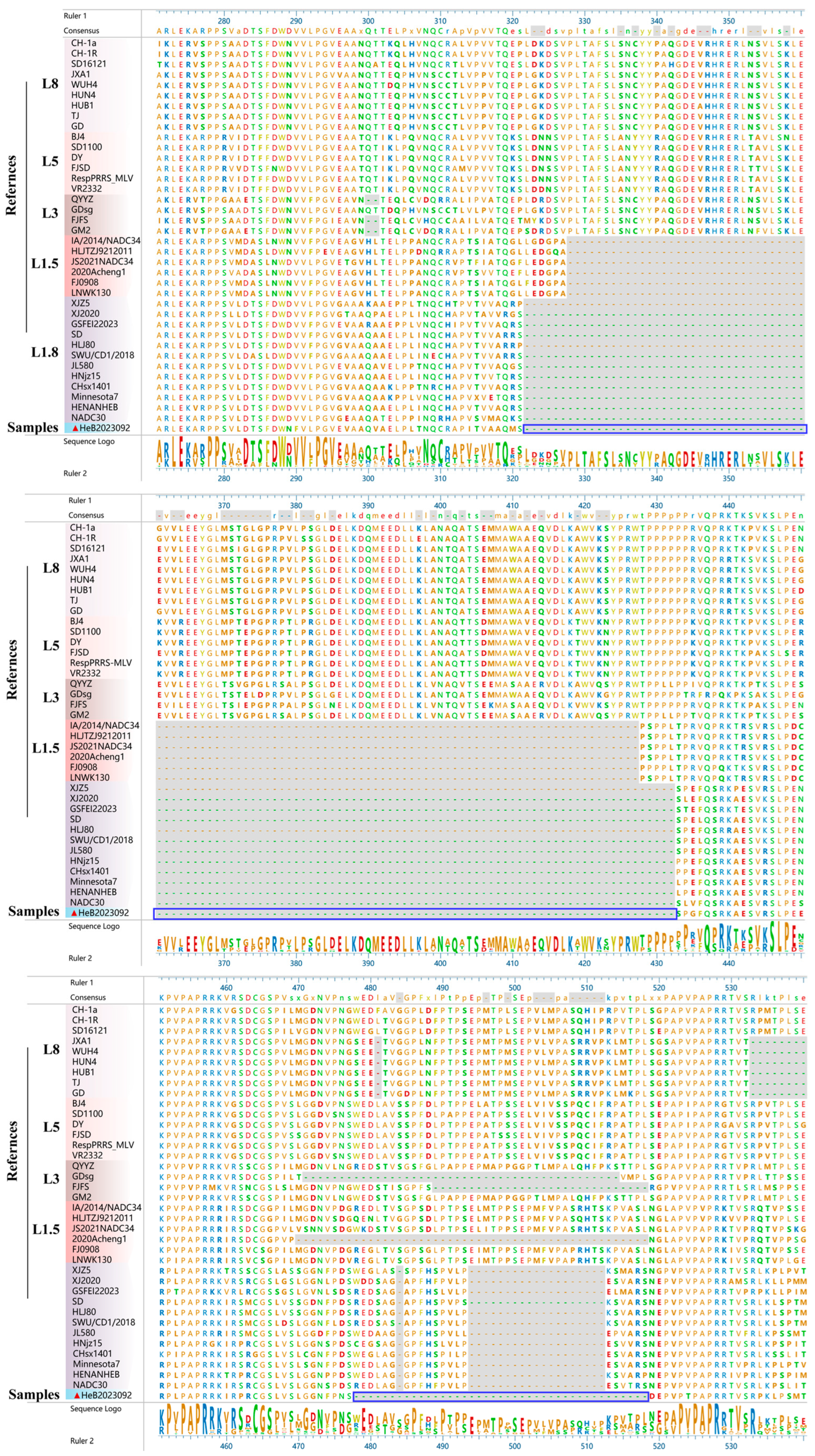
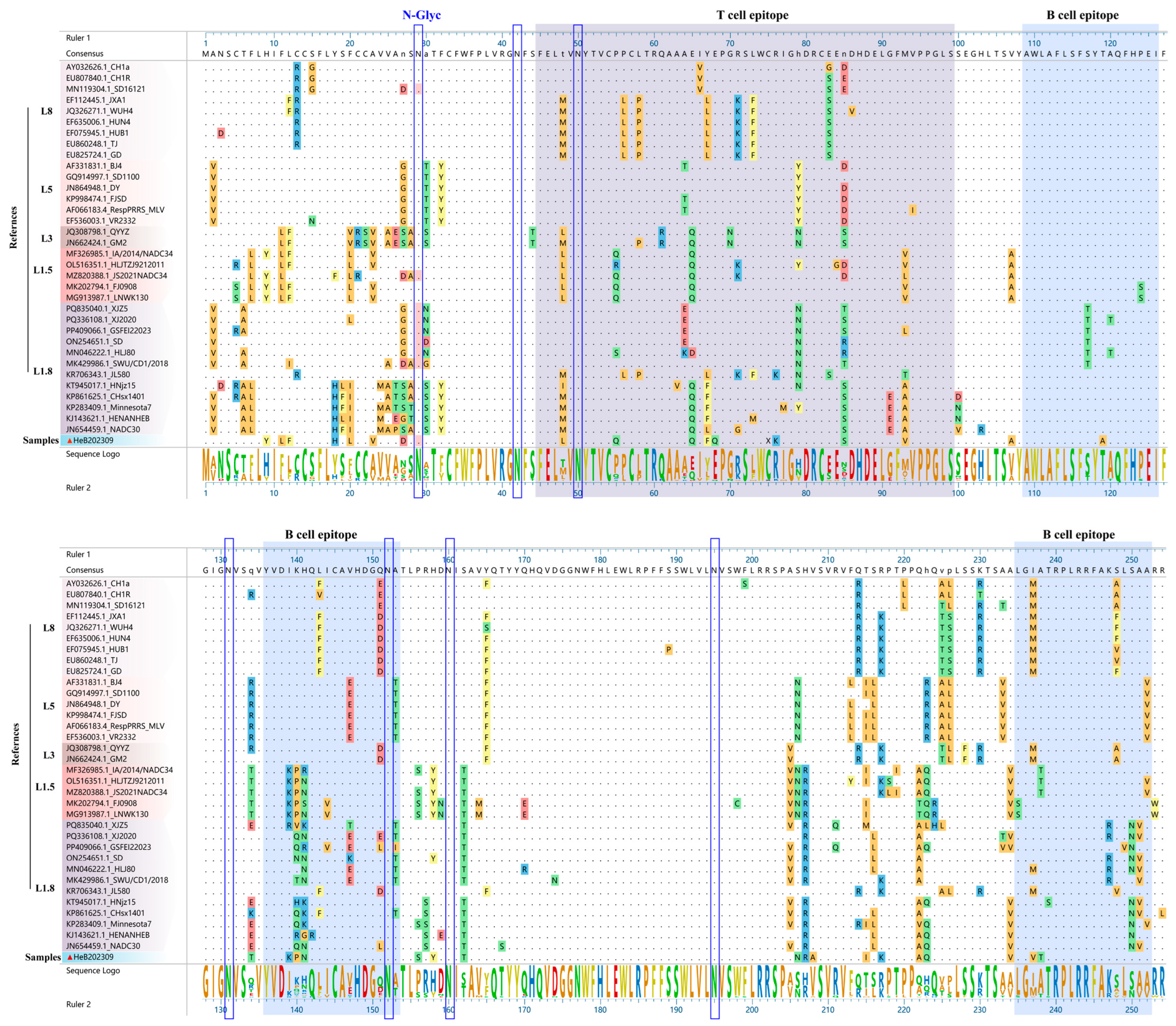
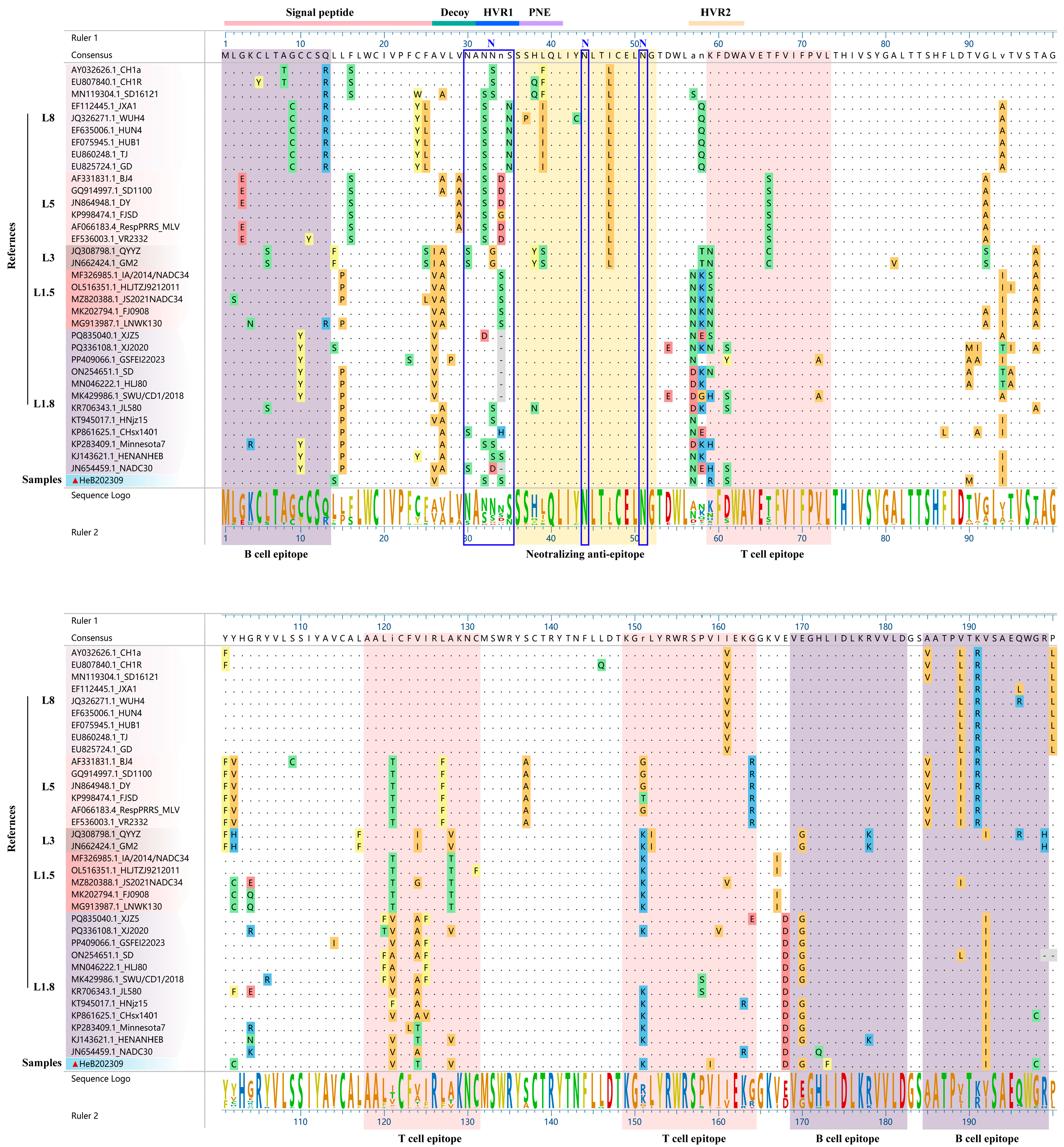
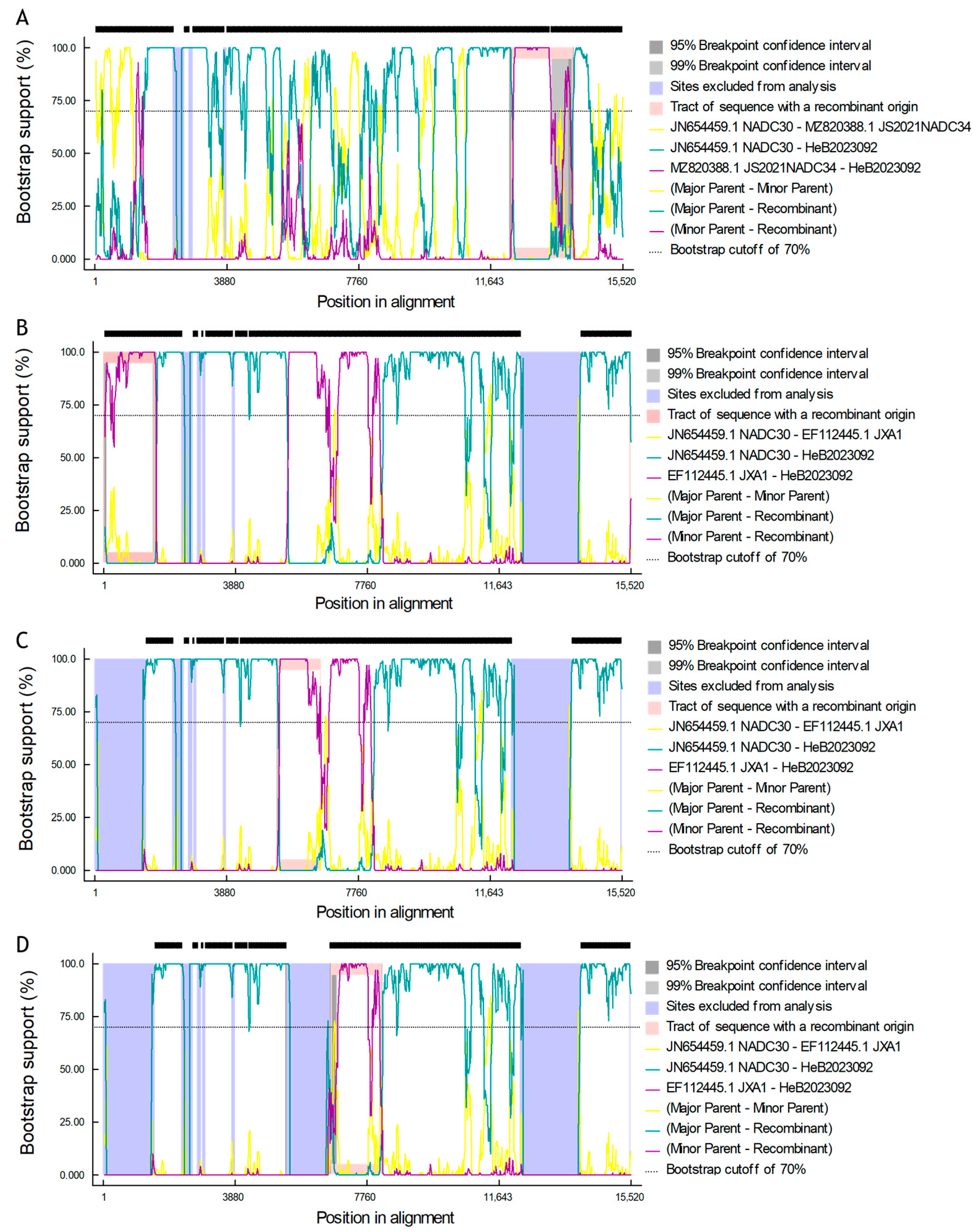
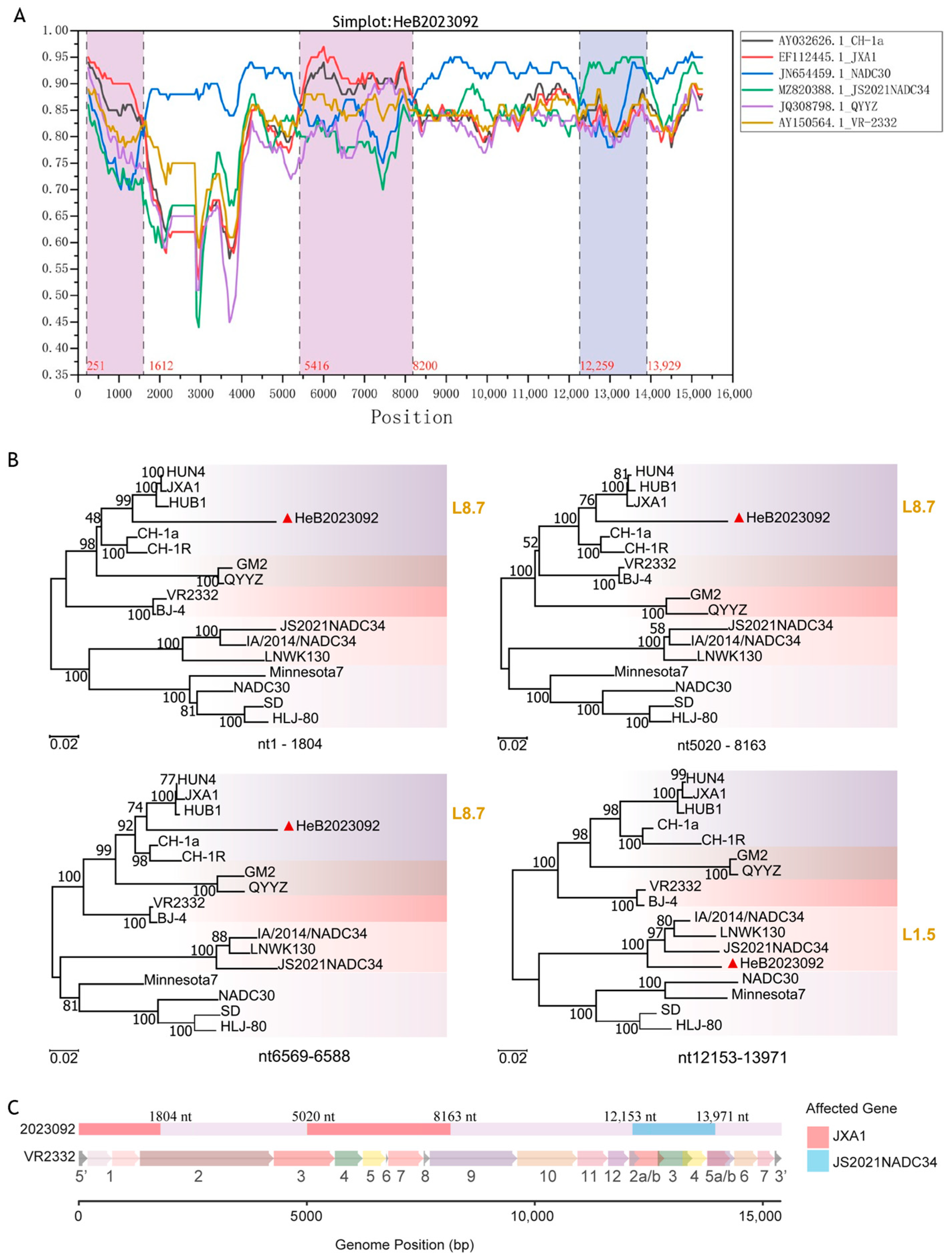
| Primer | Primer Sequences (5′-3′) |
|---|---|
| PRRSV2-UF | TTGTGCTTGCTAGGCCGC |
| PRRSV2-UR | ACGACAAATGCGTGGTTATCA |
| PRRSV-UP | FAM-TCTGGCCCCTGCCCA-MGB |
| Nsp2-F | GCTGGAAAGAGAGCAARAAAAAC |
| Nsp2-R | GCCCAGTAACCTGCCAAGAAC |
| No. | Strains | GenBank Accession No | Origin | No | Strains | GenBank Accession No | Origin |
|---|---|---|---|---|---|---|---|
| 1 | SD | ON254651.1 | China | 36 | PRRSV/G59 | OM201184.1 | China |
| 2 | HLJ-80 | MN046222.1 | China | 37 | SH2020 | OP852569.1 | China |
| 3 | SWU/CD1/2018 | MK429986.1 | China | 38 | JXA1 | EF112445.1 | China |
| 4 | XJ-Z5 | PQ835040.1 | China | 39 | CH-YY | MK450365.1 | China |
| 5 | GSFEI2-2023 | PP409066.1 | China | 40 | WUH4 | JQ326271.1 | China |
| 6 | XJ-2020 | PQ336108.1 | China | 41 | Sichuan-2017-117 | MN046236.1 | China |
| 7 | NADC30 | JN654459.1 | China | 42 | HUB1 | EF075945.1 | China |
| 8 | HNjz15 | KT945017.1 | China | 43 | FJCH | KP998477.1 | China |
| 9 | HENAN-HEB | KJ143621.1 | China | 44 | HUN4 | EF635006.1 | China |
| 10 | CHsx1401 | KP861625.1 | China | 45 | BJBLZ | FJ950745.1 | China |
| 11 | JL580 | KR706343.1 | China | 46 | TJ | EU860248.1 | China |
| 12 | Minnesota7 | KP283409.1 | USA | 47 | GD | EU825724.1 | China |
| 13 | IA/2014/ISU-8 | MF326995.1 | USA | 48 | CWZ-1-F3 | FJ889130.1 | China |
| 14 | IA/2014/NADC34 | MF326985.1 | USA | 49 | SX-1 | GQ857656.1 | China |
| 15 | IA/2015/ISU-10 | MF326997.1 | USA | 50 | CH-1a | AY032626.1 | China |
| 16 | NC 174S/2019 | ON844088.1 | USA | 51 | CH-1R | EU807840.1 | China |
| 17 | OH/2014/ISU-7 | MF326994.1 | USA | 52 | NADC30 | JN654459.1 | USA |
| 18 | OH155-2015 | KR534894.1 | USA | 53 | GS2002 | EU880441.2 | China |
| 19 | CH/2018/NCV-Anheal-1 | MH370474.1 | China | 54 | BJ-4 | AF331831.1 | China |
| 20 | HLJTZJ921-2011 | OL516351.1 | China | 55 | SD1-100 | GQ914997.1 | China |
| 21 | HLHDZD32-1901 | MN648449.1 | China | 56 | RespPRRS MLV | AF066183.4 | USA |
| 22 | 2020-Acheng-1 | MW079495.1 | China | 57 | DY | JN864948.1 | China |
| 23 | FJ0908 | MK202794.1 | China | 58 | VR2332 | EF536003.1 | USA |
| 24 | LNWK130 | MG913987.1 | China | 59 | FJSD | KP998474.1 | China |
| 25 | JS2021NADC34 | MZ820388.1 | China | 60 | CH/SCGY-2/2020 | MZ747438.1 | China |
| 26 | QYYZ | JQ308798.1 | China | 61 | GZ1101 | KF771273.1 | China |
| 27 | GM2 | JN662424.1 | China | 62 | TY | KP998428.1 | China |
| 28 | FJFS | KP998476.1 | China | 63 | GZ0308 | PQ338766.1 | China |
| 29 | SDWH27-1710 | MK780824.1 | China | 64 | NVDC-FJ | KC492506.1 | China |
| 30 | GDsg | KX621003.1 | China | 65 | BE 08V156 | MW053397.1 | Belgium |
| 31 | PRRSV/G128 | OM201187.1 | China | 66 | Lelystad virus | NC_043487.1 | The Netherlands |
| 32 | GXNN20210906 | OR468246.1 | China | 67 | IVI-1173 | KX622783.1 | Switzerland |
| 33 | GD-KP | KU978619.1 | China | 68 | lena | JF802085.1 | Belarus |
| 34 | PRRSV2/CN/L4/2020 | OL422822.1 | China | 69 | Lleida 29 22 | PQ337361.1 | Spain |
| 35 | GDYJ0718-7 | PP065918.1 | China | 70 | PRRSV1/CN/FJFQ-1/2023 | OR260421.1 | China |
| Strains | N-Glycosylation Sites | Numbers |
|---|---|---|
| CH-1a | N34, N44, N5 | 3 |
| CH-1R | N34, N44, N51 | 3 |
| SD1612-1 | N30, N34, N44, N51 | 4 |
| JXA1 | N30, N35, N44, N5 | 4 |
| WUH4 | N30, N44, N51 | 3 |
| HUB1 | N30, N35, N44, N5 | 4 |
| HUN4 | N30, N35, N44, N51 | 4 |
| TJ | N30, N35, N44, N51 | 4 |
| GD | N30, N35, N44, N51 | 4 |
| BJ-4 | N30, N33, N44, N51 | 4 |
| SD1-100 | N30, N33, N44, N51 | 4 |
| RespPRRS MLV | N30, N33, N44, N51 | 4 |
| DY | N30, N33, N44, N51 | 4 |
| VR2332 | N33, N44, N51 | 3 |
| FJSD | N30, N33, N44, N51 | 4 |
| QYYZ | N30, N33, N44, N51 | 4 |
| GM2 | N34, N44, N51 | 3 |
| IA/2014/NADC34 | N32, N33, N44, N51, N57 | 5 |
| HLJTZJ921-2011 | N32, N33, N44, N51, N57 | 5 |
| FJ0908 | N32, N33, N44, N51 | 4 |
| LNWK130 | N32, N33, N44, N51 | 4 |
| JS2021NADC34 | N32, N33, N44, N51 | 4 |
| SD | N32, N33, N43, N50 | 4 |
| HLJ-80 | N32, N33, N43, N50 | 4 |
| SWU/CD1/2018 | N32, N33, N43, N50 | 4 |
| XJ-Z5 | N33, N43, N50, N56 | 4 |
| GSFEI2-2023 | N32, N33, N43, N50 | 4 |
| XJ-2020 | N32, N33, N43, N50, N58 | 5 |
| NADC30 | N32, N43, N50 | 3 |
| HNjz15 | N34, N44, N51 | 3 |
| HENAN-HEB | N32, N44, N51 | 3 |
| CHsx1401 | N34, N44, N51 | 3 |
| JL580 | N34, N44, N51 | 3 |
| Minnesota7 | N30, N34, N44, N51 | 4 |
| HeB2023092 | N30, N33, N44, N51 | 4 |
| No. | Breakpoint Positions | Minor Strains | Major Strains | Detection Methods | |||||||
|---|---|---|---|---|---|---|---|---|---|---|---|
| Begin | End | R | G | B | M | C | S | T | |||
| 1 | 12,152 | 13,961 | JS2021NADC34 | NADC30 | + | + | + | + | + | + | + |
| 2 | 1 | 1508 | JXA1 | NADC30 | + | + | + | + | + | + | + |
| 3 | 5280 | 6568 | JXA1 | NADC30 | + | + | + | + | + | + | + |
| 4 | 6589 | 8076 | JXA1 | NADC30 | + | + | + | + | + | + | + |
Disclaimer/Publisher’s Note: The statements, opinions and data contained in all publications are solely those of the individual author(s) and contributor(s) and not of MDPI and/or the editor(s). MDPI and/or the editor(s) disclaim responsibility for any injury to people or property resulting from any ideas, methods, instructions or products referred to in the content. |
© 2025 by the authors. Licensee MDPI, Basel, Switzerland. This article is an open access article distributed under the terms and conditions of the Creative Commons Attribution (CC BY) license (https://creativecommons.org/licenses/by/4.0/).
Share and Cite
Ye, Z.; Zhang, M.; Yuan, L.; Wang, W.; Zhu, Z.; Wen, W.; Tian, K.; Li, X. Molecular Characterization of a Recombinant NADC30-like PRRSV Strain with a Novel Gene Deletion Pattern in Nsp2 Gene. Vet. Sci. 2025, 12, 983. https://doi.org/10.3390/vetsci12100983
Ye Z, Zhang M, Yuan L, Wang W, Zhu Z, Wen W, Tian K, Li X. Molecular Characterization of a Recombinant NADC30-like PRRSV Strain with a Novel Gene Deletion Pattern in Nsp2 Gene. Veterinary Sciences. 2025; 12(10):983. https://doi.org/10.3390/vetsci12100983
Chicago/Turabian StyleYe, Zhengqin, Miaojie Zhang, Lin Yuan, Wenqiang Wang, Zhenbang Zhu, Wei Wen, Kegong Tian, and Xiangdong Li. 2025. "Molecular Characterization of a Recombinant NADC30-like PRRSV Strain with a Novel Gene Deletion Pattern in Nsp2 Gene" Veterinary Sciences 12, no. 10: 983. https://doi.org/10.3390/vetsci12100983
APA StyleYe, Z., Zhang, M., Yuan, L., Wang, W., Zhu, Z., Wen, W., Tian, K., & Li, X. (2025). Molecular Characterization of a Recombinant NADC30-like PRRSV Strain with a Novel Gene Deletion Pattern in Nsp2 Gene. Veterinary Sciences, 12(10), 983. https://doi.org/10.3390/vetsci12100983








